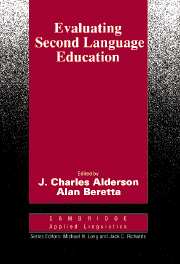Book contents
- Frontmatter
- Contents
- List of contributors
- Series editors' preface
- Acknowledgements
- Introduction
- I EVALUATION OF LANGUAGE EDUCATION: AN OVERVIEW
- II CASE STUDIES OF CURRENT PRACTICE
- Chapter 1 Insiders, outsiders and participatory evaluation
- Chapter 2 Evaluating a program inside and out
- Chapter 3 The ‘independent’ evaluation of bilingual primary education: a narrative account
- Chapter 4 Issues in evaluating input-based language teaching programs
- Chapter 5 Program-defining evaluation in a decade of eclecticism
- Chapter 6 Evaluation of classroom interaction
- Chapter 7 Moving the goalposts: project evaluation in practice
- Chapter 8 What can he learned from the Bangalore Evaluation
- III GUIDELINES FOR THE EVALUATION OF LANGUAGE EDUCATION
- Appendices
- Author Index
Chapter 6 - Evaluation of classroom interaction
from II - CASE STUDIES OF CURRENT PRACTICE
Published online by Cambridge University Press: 05 October 2012
- Frontmatter
- Contents
- List of contributors
- Series editors' preface
- Acknowledgements
- Introduction
- I EVALUATION OF LANGUAGE EDUCATION: AN OVERVIEW
- II CASE STUDIES OF CURRENT PRACTICE
- Chapter 1 Insiders, outsiders and participatory evaluation
- Chapter 2 Evaluating a program inside and out
- Chapter 3 The ‘independent’ evaluation of bilingual primary education: a narrative account
- Chapter 4 Issues in evaluating input-based language teaching programs
- Chapter 5 Program-defining evaluation in a decade of eclecticism
- Chapter 6 Evaluation of classroom interaction
- Chapter 7 Moving the goalposts: project evaluation in practice
- Chapter 8 What can he learned from the Bangalore Evaluation
- III GUIDELINES FOR THE EVALUATION OF LANGUAGE EDUCATION
- Appendices
- Author Index
Summary
Until relatively recently, the tradition in the field of language teaching and learning has been to expect a better understanding of the teaching/learning phenomenon by making a broad comparison between the learning outcomes and the teacher's plan. The focus was set on the extreme poles of the situation under investigation: those of methods and outcomes. What happened during the implementation of the method was largely ignored when it came to the evaluation of the learning outcomes. This approach is illustrated by the large-scale projects conducted by Scherer and Wertheimer (1964) and Smith (1970), who focused on outcomes and paid relatively little attention to process (see Part I, this volume).
This chapter proposes to analyse and evaluate what is claimed to be learned from classroom interaction. The method, which will be described later, allows a detailed study of the classroom interactive processes in attempting to uncover and evaluate the quality of interaction which leads to learners’ claims of uptake. (Uptake is defined as what learners claim to have learned from a particular lesson.)
Importance of the study of classroom interaction
Allwright (1984a) suggests that a high proportion of apparent mismatches between teaching and learning could be explained if instruction is perceived as being the product of both teachers’ and learners’ contributions. Learning outcomes are not necessarily the reflection of the teacher's plan since, in the process of accomplishing instructional objectives, interactive work takes place among the participants and leads to the creation of a whole range of learning opportunities, many of which are perhaps unexpected.
- Type
- Chapter
- Information
- Evaluating Second Language Education , pp. 197 - 221Publisher: Cambridge University PressPrint publication year: 1992
- 34
- Cited by

